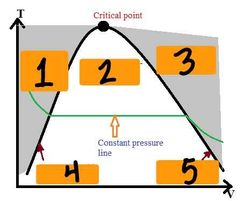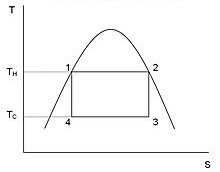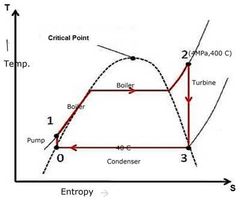![]()
![]()
![]()
Use LEFT and RIGHT arrow keys to navigate between flashcards;
Use UP and DOWN arrow keys to flip the card;
H to show hint;
A reads text to speech;
37 Cards in this Set
- Front
- Back
|
Is a system in which no transfer of mass may cross the system boundary but energy transfer may occur |
Closed system (control mass) |
|
|
Is a system in which Mass may cross the boundary in addition to the energy mass is flowing across the boundary |
Open system (control volume) |
|
|
A transformation from one state to another which is defined by changes in properties |
A process |
|
|
Is a property that is dependent on the size of the system; examples include mass, volume, energy |
Extensive property |
|
|
Values that are independent of the size of the system, name examples (4) |
Intensive property Density, specific volume, pressure, temperature |
|
|
is the transfer of energy from more energetic particles of a substance to adjacent particles that are less energetic due to interactions between particles, is stationary heat transfer between liquids, solids, and gases |
Conduction |
|
|
Is the energy transfer between a solid surface and an adjacent gas or liquid flowing across it |
Convection |
|
|
Is the energy transfer that requires no medium the energy, is transported by electromagnetic waves or photons |
Radiation |
|
|
a system that undergoes a cycle that delivers a network transfer of energy to its surroundings while communicating thermally with two bodies one hot and one cold |
Power cycle |
|
|
a system that undergoes a cycle that transfers energy by heat into the system from a cold body and discharges energy by heat transfer from the system to a hot body |
Refrigeration cycle |
|
|
A system that undergoes a cycle that transfers energy by heat into a system from a cold body and discharges energy by heat from the system to a hot body |
Heat pump cycle |
|

Label 1 to 5 |

|
|
|
When can a gas be treated as ideal? |
Using the compressibility chart as Z approaches one the gas can be treated as an ideal gas |
|
|
a device in which work is done on a gas flowing through the device in order to change the state of the gas, typically to increase the pressure |
Compressor |
|
|
A flow passage of varying cross-sectional area in which the velocity of a gas or liquid increases in the direction of flow |
Nozzle |
|
|
a device and which Powers developed as a result of a gas or liquid passing through a set of blades attached to a shaft free to rotate |
Turbine |
|
|
A device in which work is done on a liquid flowing through the device in order to change the state of the liquid, typically to increase the pressure and/or elevation |
Pump |
|
|
a device that achieves a significant reduction in pressure by introducing a restriction into the line through which a gas or liquid flows |
Throttling device |
|
|
What is the advantage of a superheated Rankine cycle? |
They have a higher average temperature so the thermal efficiency is higher, it increases steam quality at turbine exit and turbines don't like liquids so that's good |
|
|
What are some pros and cons of the Brayton cycle with reheat? |
-they have a greater net work, temperature at the turbine exit is higher so potential for regeneration is better, decreases bwr -bad because it decreases thermal efficiency |
|
|
Is a macroscopic characteristic that is numerical and independent of the system's history |
Property |
|
|
Is work a property? |
No |
|
|
What is internal energy and how is it expressed? |
The energy from the breakage of chemical bonds, expressed as ∆U |
|
|
Specifies the number of independent properties |
State principle |
|
|
Name some irreversibilities in a system |
- heat transfer through a finite temperature difference - expansion of a gas or liquid to a lower pressure - spontaneous chemical reaction - friction - current flow through our resistance - magnetization or polarization |
|
|
What is the reason for using the approximated reversible processes? |
Determine the best performance, implement factors to account for inefficiencies after |
|
|
What are the Carnot corollaries? |
- all reversible power cycles between two thermal reservoirs have the same efficiency - efficiency of a irreversible power cycle is less than the reversible power cycle |
|
|
A process in which heat isn't transferred between the system and the surroundings, there's no change in entropy |
Adiabatic |
|
|
Heat transfer goes from the hotter to colder and less work is done |
The Clausius statement |
|
|
In thermodynamics cycles not all of the heat transfer from a thermal reservoir will be converted to work |
Kelvin-Planck statement |
|
|
What makes for a thermal reservoir? |
Absorbs or supplies finite amounts of heat without changing temperature |
|
|
What is an isentropic cycle? |
Both adiabatic and reversible |
|
|
What will fix the state? |
Knowing two independent properties - P and T inside the vapor dome = NO - quality and P or T outside the vapor dome = NO |
|
|
Can a reversible power cycle achieve a cycle efficiency of 100%? |
No |
|
|
Why is it good to decrease mass flow? |
Smaller pump, small heat exchanges equal cost efficient |
|

Which cycle is represented? |
Carnot Cycle |
|

Which cycle is represented? |
Ideal Rankine cycle |

